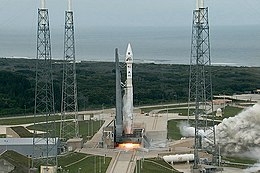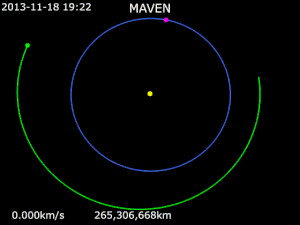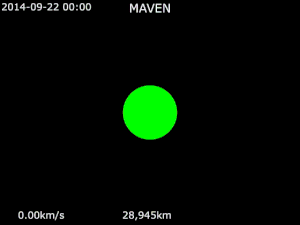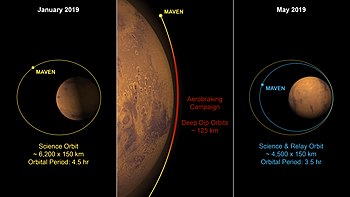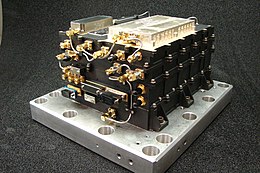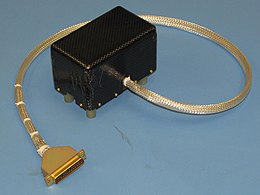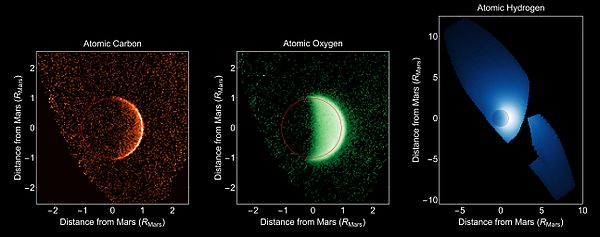
2001 Mars Odyssey is a robotic spacecraft orbiting the planet Mars. The project was developed by NASA, and contracted out to Lockheed Martin, with an expected cost for the entire mission of US$297 million. Its mission is to use spectrometers and a thermal imager to detect evidence of past or present water and ice, as well as study the planet's geology and radiation environment. It is hoped that the data Odyssey obtains will help answer the question of whether life existed on Mars and create a risk-assessment of the radiation that future astronauts on Mars might experience. It also acts as a relay for communications between the Curiosity rover, and previously the Mars Exploration Rovers and Phoenix lander, to Earth. The mission was named as a tribute to Arthur C. Clarke, evoking the name of his and Stanley Kubrick's 1968 film 2001: A Space Odyssey.

The solar wind is a stream of charged particles released from the upper atmosphere of the Sun, called the corona. This plasma mostly consists of electrons, protons and alpha particles with kinetic energy between 0.5 and 10 keV. The composition of the solar wind plasma also includes a mixture of materials found in the solar plasma: trace amounts of heavy ions and atomic nuclei of elements such as C, N, O, Ne, Mg, Si, S, and Fe. There are also rarer traces of some other nuclei and isotopes such as P, Ti, Cr, and 58Ni, 60Ni, and 62Ni. Superimposed with the solar-wind plasma is the interplanetary magnetic field. The solar wind varies in density, temperature and speed over time and over solar latitude and longitude. Its particles can escape the Sun's gravity because of their high energy resulting from the high temperature of the corona, which in turn is a result of the coronal magnetic field. The boundary separating the corona from the solar wind is called the Alfvén surface.

The Pioneer Venus project was part of the Pioneer program consisting of two spacecraft, the Pioneer Venus Orbiter and the Pioneer Venus Multiprobe, launched to Venus in 1978. The program was managed by NASA's Ames Research Center.

Nozomi was a Japanese Mars orbiter that failed to reach Mars due to electrical failure. It was constructed by the Institute of Space and Astronautical Science, University of Tokyo and launched on July 4, 1998, at 03:12 JST with an on-orbit dry mass of 258 kg and 282 kg of propellant. The Nozomi mission was terminated on December 31, 2003.

Mars 96 was a failed Mars mission launched in 1996 to investigate Mars by the Russian Space Forces and not directly related to the Soviet Mars probe program of the same name. After failure of the second fourth-stage burn, the probe assembly re-entered the Earth's atmosphere, breaking up over a 320 km (200 mi) long portion of the Pacific Ocean, Chile, and Bolivia. The Mars 96 spacecraft was based on the Phobos probes launched to Mars in 1988. They were of a new design at the time and both ultimately failed. For the Mars 96 mission the designers believed they had corrected the flaws of the Phobos probes, but the value of their improvements was never demonstrated due to the destruction of the probe during the launch phase.
Atmospheric escape is the loss of planetary atmospheric gases to outer space. A number of different mechanisms can be responsible for atmospheric escape; these processes can be divided into thermal escape, non-thermal escape, and impact erosion. The relative importance of each loss process depends on the planet's escape velocity, its atmosphere composition, and its distance from its star. Escape occurs when molecular kinetic energy overcomes gravitational energy; in other words, a molecule can escape when it is moving faster than the escape velocity of its planet. Categorizing the rate of atmospheric escape in exoplanets is necessary to determining whether an atmosphere persists, and so the exoplanet's habitability and likelihood of life.

The atmosphere of Mars is the layer of gases surrounding Mars. It is primarily composed of carbon dioxide (95%), molecular nitrogen (2.8%), and argon (2%). It also contains trace levels of water vapor, oxygen, carbon monoxide, hydrogen, and noble gases. The atmosphere of Mars is much thinner than Earth's. The average surface pressure is only about 610 pascals (0.088 psi) which is less than 1% of the Earth's value. The currently thin Martian atmosphere prohibits the existence of liquid water on the surface of Mars, but many studies suggest that the Martian atmosphere was much thicker in the past. The higher density during spring and fall is reduced by 25% during the winter when carbon dioxide partly freezes at the pole caps. The highest atmospheric density on Mars is equal to the density found 35 km (22 mi) above the Earth's surface and is ≈0.020 kg/m3. The atmosphere of Mars has been losing mass to space since the planet's core slowed down, and the leakage of gases still continues today. The atmosphere of Mars is colder than Earth's. Owing to the larger distance from the Sun, Mars receives less solar energy and has a lower effective temperature, which is about 210 K. The average surface emission temperature of Mars is just 215 K, which is comparable to inland Antarctica. Although Mars' atmosphere consists primarily of carbon dioxide, the greenhouse effect in the Martian atmosphere is much weaker than Earth's: 5 °C (9.0 °F) on Mars, versus 33 °C (59 °F) on Earth. This is because the total atmosphere is so thin that the partial pressure of carbon dioxide is very weak, leading to less warming. The daily range of temperature in the lower atmosphere is huge due to the low thermal inertia; it can range from −75 °C (−103 °F) to near 0 °C (32 °F) near the surface in some regions. The temperature of the upper part of the Martian atmosphere is also significantly lower than Earth's because of the absence of stratospheric ozone and the radiative cooling effect of carbon dioxide at higher altitudes.
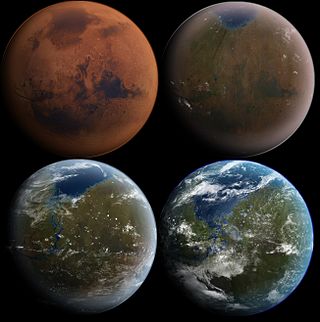
The terraforming of Mars or the terraformation of Mars is a hypothetical procedure that would consist of a planetary engineering project or concurrent projects, with the goal to transform Mars from a planet hostile to terrestrial life to one that can sustainably host humans and other lifeforms free of protection or mediation. The process would involve the modification of the planet's extant climate, atmosphere, and surface through a variety of resource-intensive initiatives, and the installation of a novel ecological system or systems.

The climate of Mars has been a topic of scientific curiosity for centuries, in part because it is the only terrestrial planet whose surface can be easily directly observed in detail from the Earth with help from a telescope.

The Magnetospheric Multiscale (MMS) Mission is a NASA robotic space mission to study the Earth's magnetosphere, using four identical spacecraft flying in a tetrahedral formation. The spacecraft were launched on 13 March 2015 at 02:44 UTC. The mission is designed to gather information about the microphysics of magnetic reconnection, energetic particle acceleration, and turbulence — processes that occur in many astrophysical plasmas. As of March 2020, the MMS spacecraft have enough fuel to remain operational until 2040.

Bruce Martin Jakosky is a professor of Geological Sciences and associate director of the Laboratory for Atmospheric and Space Physics (LASP) at the University of Colorado, Boulder. He has been involved with the Viking, Solar Mesosphere Explorer, Clementine, Mars Observer, Mars Global Surveyor, Mars Odyssey, Mars Science Laboratory and MAVEN spacecraft missions, and is involved in planning future spacecraft missions.

C/2013 A1 is an Oort cloud comet discovered on 3 January 2013 by Robert H. McNaught at Siding Spring Observatory using the 0.5-meter (20 in) Uppsala Southern Schmidt Telescope.

The Heliophysics Science Division of the Goddard Space Flight Center (NASA) conducts research on the Sun, its extended Solar System environment, and interactions of Earth, other planets, small bodies, and interstellar gas with the heliosphere. Division research also encompasses geospace—Earth's uppermost atmosphere, the ionosphere, and the magnetosphere—and the changing environmental conditions throughout the coupled heliosphere.
The following outline is provided as an overview of and topical guide to Mars:

SWAP is a science instrument aboard the unmanned New Horizons space probe, which was designed to fly by dwarf planet Pluto. SWAP was designed to record Solar Wind en route, at, and beyond Pluto. At Pluto, SWAP's purpose was to record the relationship between the solarwind and ions and/or material entering space from the atmosphere of Pluto.

Pluto Energetic Particle Spectrometer Science Investigation (PEPSSI), is an instrument on the New Horizons space probe to Pluto and beyond, it is designed to measure ions and electrons. Specifically, it is focused on measuring ions escaping from the atmosphere of Pluto during the 2015 flyby. It is one of seven major scientific instruments aboard the spacecraft. The spacecraft was launched in 2006, flew by Jupiter the following year, and went onto flyby Pluto in 2015 where PEPSSI was able to record and transmit back to Earth its planned data collections.

REX or Radio Science Experiment is an experiment on the New Horizons space probe to determine various aspects of the atmosphere of Pluto during the 2015 flyby.

Shannon Curry is the Principal Investigator of the NASA Mars Scout mission MAVEN. She is a planetary physicist and the Deputy Assistant Director of Planetary Science at the Space Sciences Laboratory at the University of California, Berkeley.
Jane Lee Fox is a physicist known for her research on the atmosphere of planets including Mars and Venus.


